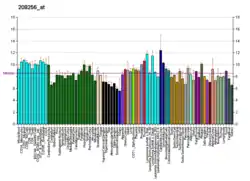Ephrin A2
Ephrin-A2 is a protein that in humans is encoded by the EFNA2 gene.[5]
| EFNA2 | |||||||||||||||||||||||||||||||||||||||||||||||||||
|---|---|---|---|---|---|---|---|---|---|---|---|---|---|---|---|---|---|---|---|---|---|---|---|---|---|---|---|---|---|---|---|---|---|---|---|---|---|---|---|---|---|---|---|---|---|---|---|---|---|---|---|
| |||||||||||||||||||||||||||||||||||||||||||||||||||
| Identifiers | |||||||||||||||||||||||||||||||||||||||||||||||||||
| Aliases | EFNA2, ELF-1, EPLG6, HEK7-L, LERK-6, LERK6, ephrin A2 | ||||||||||||||||||||||||||||||||||||||||||||||||||
| External IDs | OMIM: 602756 MGI: 102707 HomoloGene: 1075 GeneCards: EFNA2 | ||||||||||||||||||||||||||||||||||||||||||||||||||
| |||||||||||||||||||||||||||||||||||||||||||||||||||
| |||||||||||||||||||||||||||||||||||||||||||||||||||
| |||||||||||||||||||||||||||||||||||||||||||||||||||
| |||||||||||||||||||||||||||||||||||||||||||||||||||
| |||||||||||||||||||||||||||||||||||||||||||||||||||
| Wikidata | |||||||||||||||||||||||||||||||||||||||||||||||||||
| |||||||||||||||||||||||||||||||||||||||||||||||||||
This gene encodes a member of the ephrin family. The protein is composed of a signal sequence, a receptor-binding region, a spacer region, and a hydrophobic region. The EPH and EPH-related receptors comprise the largest subfamily of receptor protein-tyrosine kinases and have been implicated in mediating developmental events, particularly in the nervous system. Based on their structures and sequence relationships, ephrins are divided into the ephrin-A (EFNA) class, which are anchored to the membrane by a glycosylphosphatidylinositol linkage, and the ephrin-B (EFNB) class, which are transmembrane proteins. Posttranslational modifications determine whether this protein localizes to the nucleus or the cytoplasm.[5]
References
- GRCh38: Ensembl release 89: ENSG00000099617 - Ensembl, May 2017
- GRCm38: Ensembl release 89: ENSMUSG00000003070 - Ensembl, May 2017
- "Human PubMed Reference:". National Center for Biotechnology Information, U.S. National Library of Medicine.
- "Mouse PubMed Reference:". National Center for Biotechnology Information, U.S. National Library of Medicine.
- "Entrez Gene: EFNA2 ephrin-A2".
Further reading
- Flanagan JG, Vanderhaeghen P (1998). "The ephrins and Eph receptors in neural development". Annu. Rev. Neurosci. 21: 309–45. doi:10.1146/annurev.neuro.21.1.309. PMID 9530499.
- Zhou R (1998). "The Eph family receptors and ligands". Pharmacol. Ther. 77 (3): 151–81. doi:10.1016/S0163-7258(97)00112-5. PMID 9576626.
- Holder N, Klein R (1999). "Eph receptors and ephrins: effectors of morphogenesis". Development. 126 (10): 2033–44. doi:10.1242/dev.126.10.2033. PMID 10207129.
- Wilkinson DG (2000). "Eph receptors and ephrins: regulators of guidance and assembly". Int. Rev. Cytol. International Review of Cytology. 196: 177–244. doi:10.1016/S0074-7696(00)96005-4. ISBN 978-0-12-364600-2. PMID 10730216.
- Xu Q, Mellitzer G, Wilkinson DG (2001). "Roles of Eph receptors and ephrins in segmental patterning". Philos. Trans. R. Soc. Lond. B Biol. Sci. 355 (1399): 993–1002. doi:10.1098/rstb.2000.0635. PMC 1692797. PMID 11128993.
- Wilkinson DG (2001). "Multiple roles of EPH receptors and ephrins in neural development". Nat. Rev. Neurosci. 2 (3): 155–64. doi:10.1038/35058515. PMID 11256076. S2CID 205014301.
- Gale NW, Holland SJ, Valenzuela DM, et al. (1996). "Eph receptors and ligands comprise two major specificity subclasses and are reciprocally compartmentalized during embryogenesis". Neuron. 17 (1): 9–19. doi:10.1016/S0896-6273(00)80276-7. PMID 8755474. S2CID 1075856.
- Ephnomenclaturecommittee (1997). "Unified nomenclature for Eph family receptors and their ligands, the ephrins. Eph Nomenclature Committee". Cell. 90 (3): 403–4. doi:10.1016/S0092-8674(00)80500-0. PMID 9267020. S2CID 26773768.
- Cerretti DP, Nelson N (1998). "Characterization of the genes for mouse LERK-3/Ephrin-A3 (Epl3), mouse LERK-4/Ephrin-A4 (Epl4), and human LERK-6/Ephrin-A2 (EPLG6): conservation of intron/exon structure". Genomics. 47 (1): 131–5. doi:10.1006/geno.1997.5088. PMID 9465306.
- Ciossek T, Monschau B, Kremoser C, et al. (1998). "Eph receptor-ligand interactions are necessary for guidance of retinal ganglion cell axons in vitro". Eur. J. Neurosci. 10 (5): 1574–80. doi:10.1046/j.1460-9568.1998.00180.x. PMID 9751130. S2CID 20470923.
- Aasheim HC, Pedeutour F, Grosgeorge J, Logtenberg T (1998). "Cloning, chromosal mapping, and tissue expression of the gene encoding the human Eph-family kinase ligand ephrin-A2". Biochem. Biophys. Res. Commun. 252 (2): 378–82. doi:10.1006/bbrc.1998.9618. PMID 9826538.
- Gerlai R, Shinsky N, Shih A, et al. (1999). "Regulation of learning by EphA receptors: a protein targeting study". J. Neurosci. 19 (21): 9538–49. doi:10.1523/JNEUROSCI.19-21-09538.1999. PMC 6782889. PMID 10531456.
- Hattori M, Osterfield M, Flanagan JG (2000). "Regulated cleavage of a contact-mediated axon repellent". Science. 289 (5483): 1360–5. doi:10.1126/science.289.5483.1360. PMID 10958785.
- Rodger J, Lindsey KA, Leaver SG, et al. (2002). "Expression of ephrin-A2 in the superior colliculus and EphA5 in the retina following optic nerve section in adult rat". Eur. J. Neurosci. 14 (12): 1929–36. doi:10.1046/j.0953-816x.2001.01822.x. PMID 11860487. S2CID 24040732.




